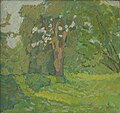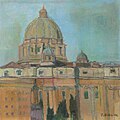Use Heller-Lazard
Ilse (Rosy) Lazard (born August 3, 1884 in Metz , Lorraine , † January 10, 1934 in Paris ) was a German-Swiss painter between Impressionism and Expressionism .
Life
Ilse Heller-Lazard was born in 1884 in Metz, Germany, to a Jewish banking family, one year before her sister Luise, also a painter who later became better known under the name Lou Albert-Lasard . While her father's family came from Saarlouis , her mother, Jenny, was a native American from Nashville . After taking private painting and drawing lessons in Metz, from 1904 both sisters attended classes at a drawing school in Munich , where the artistic dawn of modernism had already been announced. After an extensive study trip to Italy in 1907, they parted ways; Ilse Lazard then trained in Strasbourg and England. In 1910 she married the businessman Paul Gayer. After a loss-making bankruptcy, which almost led to the break with the father, the couple lived separately from 1911. The marriage was divorced at the end of 1913 without children.
From 1911 to 1914 Ilse Lazard studied at the painting school of the Baltic-German painter Johann Walter-Kurau in Dresden , whose independent interpretation of Impressionism strongly influenced her. Although his courses were attended by a large number of artists, it is not possible to say with certainty who their fellow students were. The artist community “ Brücke ”, founded in Dresden in 1905, was already part of the city's cultural tension, but initially remained unimportant for the artist. The Baltic Sea , the surroundings of Dresden as well as urban views served as motifs for her paintings of this period.
Moving to Berlin and taking lessons at the Lewin-Funcke art school, where Lovis Corinth also worked as a lecturer, brought new artistic impulses and an almost untamed color scheme to her painting in 1914. Nudes and larger formats appear; Various self-portraits reflect the critical examination of herself. It is here that she met her future second husband in 1915, the Swiss sculptor Ernst Heller . When he broke off his studies in Berlin in 1916, she followed him to Switzerland, where she mainly worked in Zurich and Ticino , but also in Heller's hometown of Eglisau on the Rhine and in the mountains. During this time the friendship with Cuno Amiet began . After a crisis that received psychiatric treatment, she married Ernst Heller in Zurich in 1918, where she continued to live until the end of 1919.
From the winter of 1919/20 the couple settled in Rome . She spent the summer of 1921 with her husband in the artists' village of Anticoli Corrado east of Rome, where she met a number of important contemporary Italian artists, such as the architect Del Debbio , the sculptor Angelo Zanelli and Felice Carena (painter) , a painter from the Scuola Romana ". During some summer periods she later stayed with her husband's relatives in Switzerland. Economic difficulties, a lack of recognition, and health and marital problems weakened her self-confidence. In Italy mainly landscapes , cityscapes and drawings were created.
At the end of 1927, the company moved to the Montparnasse district in Paris. After her father's death in 1927, she was financially somewhat more independent and was able to afford a few trips to southern and western France and Spain . Mental and physical health problems, the economic crisis, the blocking and devaluation of their assets and the alienation from their spouse led to increasing bitterness, which further reduced their productivity. Nonetheless, the works of this period reveal that current of poetic realism that was also effective in French films of the time. She died in Paris after an operation in January 1934.
Works (selection)
Group exhibitions
- Jury-free art show, Berlin 1916. Four works
- Kunsthaus Zürich, June 4–29, 1919. Fourteen works
Solo exhibitions
- Ilse Heller-Lazard: à la lumière du temps. Château de Courcelles, Montigny-lès-Metz (F), April 21st to June 1st 2018
- The Laz (s) ard sisters. Ludwig Galerie Saarlouis (DE), January 14, 2018–8. April 2018
- The order of the color. The expressionist Ilse Heller-Lazard. The Hidden Museum Berlin October 1, 2009–31. January 2010
- Use Heller-Lazard. 1884-1934. An expressionist in Eglisau. Eglisau local museum August 20, 2011–18. September 2011
- Use Heller-Lazard. 1884-1934. In the penumbra of time. Municipal Wessenberg Gallery Constance 2012
literature
- THE SISTERS LAZ (S) ARD, Ilse Heller-Lazard and Lou Albert-Lasard . Catalog, published by the Ludwig Galerie, Saarlouis. ISBN 978-3-942279-31-4 , 2018.
- Ilse Heller-Lazard, à la lumière du temps . Catalog, Expositions Château de Courcelles. 2018.
- Matthias Heller: Ilse Heller-Lazard 1884-1934. In the penumbra of time . With a catalog of works and an afterword by Matthias Fischer. Verlag Elfundzehn, Eglisau 2009. ISBN 978-3-905769-12-8 . 2nd supplemented and expanded edition. Münster Verlag GmbH 2018, ISBN 978-3-905896-78-7 .
- Between the Baltic States and Berlin. The painter Johann Walter-Kurau (1869-1932) as an artist and teacher . Published by Ralf F. Hartmann. With articles by Ralf F. Hartmann and Kristiana Abele. mdv Mitteldeutscher Verlag, Halle 2009. ISBN 978-3-89812-610-6 .
- Nicole Schneegans: Une image de Lou . Collection Page Blanche, Gallimard 1996. Biography Lou Albert-Lasard.
- Matthias Heller: Ilse Heller-Lazard . MIDI revue semestrielle, notices et notes des auteurs du n ° 40/41, 1ère Partie AK
Web links
- Matthias Fischer: Heller-Lazard, Ilse. In: Sikart
| personal data | |
|---|---|
| SURNAME | Heller-Lazard, Ilse |
| ALTERNATIVE NAMES | Lazard, Rosy |
| BRIEF DESCRIPTION | German-Swiss painter |
| DATE OF BIRTH | August 3, 1884 |
| PLACE OF BIRTH | Metz |
| DATE OF DEATH | January 10, 1934 |
| Place of death | Paris |







